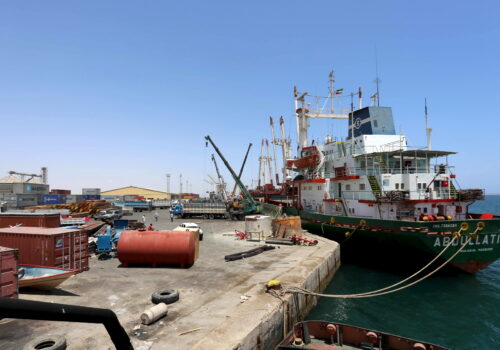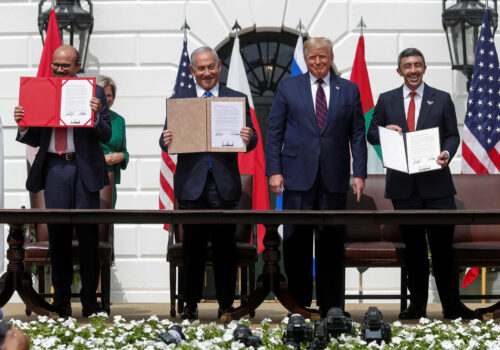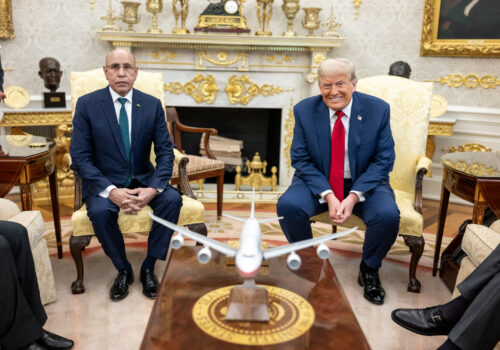The United Kingdom has joined C-SIPA. Who will be next?
On June 19, the United Kingdom officially joined the Comprehensive Security Integration and Prosperity Agreement (C-SIPA) at the invitation of the agreement’s first signatories—the United States and Bahrain.
The United Kingdom’s accession, first proposed on the sidelines of the 2024 Manama Dialogue, marks the first expansion of C-SIPA beyond its founding members. With a permanent naval base in Bahrain and a history of defense and intelligence cooperation, the United Kingdom strengthens the deterrent value of the agreement while enhancing its institutional credibility.
Beyond that, bringing the United Kingdom into the agreement is an important step as the United States and Bahrain, through C-SIPA, look to solidify a new model for multilateral security cooperation in the Middle East. The United Kingdom’s accession shifts C-SIPA from a bilateral initiative to a trusted multilateral platform, positioning it to attract additional partners and withstand political transitions in Washington. Additionally, the inclusion of a dependable transatlantic ally affirms C-SIPA’s potential as a foundation for broader regional integration.
The question now is, as the United States and Bahrain continue to build an integrated defense framework in the Middle East, who will be next to join C-SIPA?
What the United Kingdom just agreed to
Bahrain and the United States signed C-SIPA just weeks before the October 7, 2023, Hamas terrorist attack.
The agreement lays the foundation for multilateral cooperation on defense, intelligence sharing, economic initiatives, and emerging technologies. While the United States and Bahrain already maintained strong security cooperation prior to C-SIPA, the agreement formalized their partnership and elevated it to a mutual defense partnership that has been given the nickname “Article 4.5,” since C-SIPA is the strongest public security agreement the United States holds outside of NATO’s Article 5. C-SIPA accelerated joint efforts and positioned Bahrain as one of the United States’ most reliable regional defense partners.
Bahrain has lived up to its end of the bargain. Notably, in response to Houthi attacks on commercial shipping that escalated in late 2023, Bahrain was the only Arab country to publicly join each US-led military operation, including the multinational Operation Prosperity Guardian. Bahrain continues to purchase advanced US military hardware, including M1A2 Abrams tanks, which it purchased in a $2.2 billion deal in March 2024. Bahrain has also taken steps to ensure its technological ecosystem is aligned with the United States’.
SIGN UP FOR THIS WEEK IN THE MIDEAST NEWSLETTER
The June escalation between Israel and Iran demonstrated the agreement’s importance to Bahrain. Home to the US Fifth Fleet, Bahrain braced for potential fallout during the clashes, and just days before the United States struck Iran’s nuclear infrastructure, it coordinated with US personnel, prepared thirty-three emergency shelters, and conducted nationwide siren tests. Expecting it could be in the crosshairs of Iranian retaliation, Bahrain was ultimately spared when Iran targeted Al Udeid Air Base in Qatar, yet the potential of a direct incident demonstrated why the agreement remains vital to Bahrain’s security.
C-SIPA can also help facilitate cooperation well beyond defense. For example, during Crown Prince Salman bin Hamad Al Khalifa’s visit to Washington this July (which included discussions with UK officials about the importance of C-SIPA), Bahrain announced $17 billion in new investment deals with the United States. The agreements include plans to replace Chinese servers with Cisco products, strengthen partnerships with Oracle, and increase Bahraini investments in US energy, tech, and manufacturing. A separate memorandum signed by US Secretary of State Marco Rubio and Bahraini Foreign Minister Abdullatif bin Rashid Al Zayani also laid the groundwork for peaceful nuclear cooperation, a demonstration of trust and confidence. These announcements show that C-SIPA can pave the way for real economic and technological benefits in addition to defense cooperation.
On a larger scale, C-SIPA was forged with ambitions to “build a fully integrated regional security architecture in the Middle East,” in the spirit of the Abraham Accords and the Negev Forum, “with the expectation of welcoming in . . . future additional parties.” The United Kingdom’s joining the agreement, in the wake of the Twelve Day War, is a bold initial step to make C-SIPA multilateral. But to fully realize the regional security architecture that the United States and Bahrain envision, policymakers will need to expand C-SIPA within the Middle East region.
Who’s next?
I accompanied the N7 Initiative’s bipartisan congressional delegation to Bahrain this June, where Bahraini leaders reaffirmed their commitment to strengthening the agreement and emphasized its potential to serve as a foundation for broader regional cooperation. The participating members of Congress also signaled political support for the agreement’s implementation.
But to realize the agreement’s full potential, officials must continue to expand C-SIPA across the region.
To advance the agreement’s stated integration goals, which align with and support the Abraham Accords, C-SIPA should pursue a phased expansion strategy that begins with Arab partners who already maintain formal ties with Israel or share core security priorities. This is so that C-SIPA, which supports the security cooperation necessary to sustain deeper political and economic integration, can have a magnified impact in the Middle East. By beginning with these Arab partners, the agreement can help create the conditions for the Accords’ long-term success, including the eventual goal of broader regional participation.
Given its existing peace treaty with Israel and its status as a close defense partner of the United States, Jordan is well-positioned to join C-SIPA. Jordan has previously expressed support for the creation of a regional security framework, with King Abdullah II stating in a 2022 interview with CNBC that he would “be one of the first people that would endorse a Middle East NATO”—aligning well with C-SIPA, since it has been dubbed as “Article 4.5.” Early efforts to engage Jordan could focus on cooperation around border security, counterterrorism, and cyber defense.
Egypt, which also maintains a long-standing peace treaty with Israel and plays a central role in regional security, would be a valuable addition to C-SIPA, particularly given its strategic position along the Red Sea and its leadership in counterterrorism and maritime security efforts.
Jordan and Egypt joining C-SIPA would advance the Abraham Accords by turning their largely symbolic peace with Israel into deeper regional cooperation alongside the United States, the United Kingdom, and Bahrain. Their participation would reinforce the Abraham Accords’ broader goals without requiring direct bilateral engagement with Israel.
Additionally, the eventual inclusion of more Gulf Cooperation Council (GCC) countries would significantly strengthen C-SIPA’s regional credibility and operational capabilities. With long-standing defense cooperation agreements and joint training exercises with the United States, and with countries such as Kuwait, Qatar, and the United Arab Emirates (UAE) hosting US military bases, GCC members are already integrated into the US security architecture. Moreover, shared concerns about Iranian proxy activity, missile threats, and maritime security in the Gulf align closely with C-SIPA’s focus. The UAE stands out as a strong first GCC partner. It hosts US forces at Al Dhafra Air Base, has a growing technology industry, and was one of the first countries to normalize relations with Israel through the Abraham Accords. Expanding the agreement to include Gulf partners would amplify C-SIPA’s deterrent value and create new avenues for regional integration if additional GCC members sign on.
To attract new members, however, current signatories must deepen cooperation and showcase the benefits that make participation attractive. One way to do this is by standing up the defense working group stipulated in Article II of C-SIPA and adding working groups focused on areas such as economic integration and emerging technologies. Regularly convening these groups annually or biannually can yield visible outcomes and highlight the agreement’s value. These meetings could also allow for limited participation by prospective partners, offering them a chance to engage prior to formal accession and see how involvement could help further their own interests. Allowing prospective partners to participate in a limited capacity could strengthen trust with current members and lay the groundwork for eventual accession.
When Israel joins in
While immediate efforts should prioritize expanding C-SIPA among Arab partners, Israel’s inclusion should remain a long-term objective. C-SIPA has already enabled indirect alignment with Israel; following the air defense operation against Iranian missiles that took place in April last year, Bahrain hosted senior Israeli and Arab military officials as part of a meeting led by the US Central Command, which reflects quiet, practical cooperation with Israel under the umbrella of regional security coordination. Israel’s formal inclusion in C-SIPA, though likely years away, would significantly enhance the agreement’s operational effectiveness, enabling structured collaboration on missile defense, intelligence sharing, maritime security, artificial intelligence and technology, and strategic infrastructure projects such as the India–Middle East–Europe Economic Corridor.
Israel’s future inclusion in C-SIPA would also strengthen the political durability of its normalization agreement with Bahrain. Officials in Manama have stressed that cooperation with Israel must yield visible results to sustain domestic support. Israel’s experience countering Iranian missile and drone attacks, combined with its advanced early warning systems and cyber capabilities, would strengthen C-SIPA’s value. Along with traditional defense support, Israel could also contribute to the development of joint innovation platforms in emerging sectors such as artificial intelligence and cybersecurity, where it already has a competitive edge. Integrating Israel into C-SIPA could deliver tangible outcomes for Bahrain, shifting normalization from symbolic diplomacy to a platform for practical cooperation and mutual defense.
For the United States, integrating Israel into C-SIPA would constitute a shift from decades of bilateral defense coordination to a more multilateral framework. The United States and Israel have a history of collaboration on missile defense systems such as the Iron Dome and David’s Sling, which are co-developed and co-funded. Including Israel in C-SIPA would elevate this cooperation to a regional scale by allowing for potential integration with GCC air defense systems and US command structures, enhancing interoperability and minimizing redundancies.
However, bringing Israel into C-SIPA too early could discourage Arab participation and raise expectations for formal US security guarantees. Prioritizing the inclusion of Arab partners would help build regional consensus and demonstrate that C-SIPA is intended to support shared regional interests, rather than simply advancing a narrower US-Israeli agenda. Focused cooperation on shared priorities such as air and missile defense, maritime security, and cybersecurity among aligned regional and international partners can create the conditions for Israel’s future participation.
Focusing on Arab participation first would also give countries that cannot currently justify formal engagement with Israel, given the ongoing war, an opportunity to join the agreement and gradually build comfort with the idea of Israeli partnership in the future. Over time, this phased approach would allow C-SIPA to develop into a durable regional security framework.
In an increasingly volatile region, the kind of integrated planning and coordination outlined in C-SIPA is essential. With the right political investment, C-SIPA can serve as the foundation for a durable, multilateral architecture that strengthens collective security, bolsters deterrence, and advances long-term regional integration.
Cassidy McGoldrick is the assistant director for the N7 Initiative, a partnership between the Atlantic Council and Jeffrey M. Talpins Foundation.
Further reading
Thu, Jul 31, 2025
Gateways to the Red Sea: The case for Israel–Somaliland normalization
MENASource By
Expanding the Abraham Accords to Somaliland could quietly anchor a more stable and cooperative Red Sea region.
Thu, Jul 17, 2025
Five years on, the Abraham Accords need a multilateral mission
MENASource By
As the Trump administration pushes for “commerce, not chaos” in the region, the Abraham Accords ideology is the most powerful tool to achieve that goal.
Wed, Jul 16, 2025
How Mauritania-Israel normalization may boost US posture in the Sahel
MENASource By Sarah Zaaimi
If Mauritania is nearing a deal with Israel, this could be the beginning of a wider re-engagement with Sahel countries.
Image: July 17, 2025, Arlington, Virginia, USA: U.S. Defense Secretary Pete Hegseth (R) welcomes Bahrain Crown Prince Salman bin Hamad Al Khalifa (L) at the Pentagon in Washington, D.C., on July 17, 2025. (Credit Image: © Mehmet Eser/ZUMA Press Wire)



